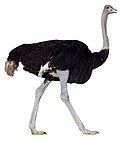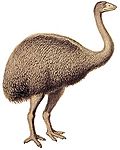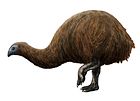| Diogenornis Temporal range: Middle Paleocene-Early Eocene (Riochican-Casamayoran) ~57–48.6 Ma PreꞒ Ꞓ O S D C P T J K Pg N | |
|---|---|
| Scientific classification | |
| Domain: | Eukaryota |
| Kingdom: | Animalia |
| Phylum: | Chordata |
| Class: | Aves |
| Infraclass: | Palaeognathae |
| Order: | Casuariiformes |
| Genus: | †Diogenornis Alvarenga 1983 |
| Type species | |
| †Diogenornis fragilis Alvarenga 1983 | |
Diogenornis is an extinct genus of ratites, that lived from the Middle Paleocene to the Early Eocene (Riochican to Casamayoran in the SALMA classification). It was described in 1983 by Brazilian scientist Herculano Marcos Ferraz de Alvarenga based on fossils found in the Itaboraí Formation in southeastern Brazil. The type species is D. fragilis. It grew to about two thirds the size of the modern greater rhea, at about 90 centimetres (3.0 ft) of height.
Description
While initially considered a member of the family Opisthodactylidae, further examination of the fossil remains showed that it was more similar to the modern rhea. According to Gerald Mayr, Diogenornis is best considered a stem-group member of the Rheidae. However, recent phylogenetic studies have shown a closer affiliation to Australian ratites, the cassowaries and emus. This may reevaluate the origins and distribution of this clade, expanding their range to the South American Paleocene, well before the appearance of Emuarius. Recent findings nonetheless show that it co-existed with early rheas, meaning the ratite diversity of South America was very high during the Paleogene.
Diogenornis possesses a rather narrow beak, similar to that of tinamous, lithornithids and cassowaries, as well as rather large wings. These traits, both rather unspecialised, seem to suggest a then recent development from a flying ancestor.
References
- Agnolin, Federico L. (July 2016) . "Unexpected diversity of ratites (Aves, Palaeognathae) in the early Cenozoic of South America: Palaeobiogeographical implications". Alcheringa: An Australasian Journal of Palaeontology. 41 (1): 101–111. doi:10.1080/03115518.2016.1184898. ISSN 0311-5518. S2CID 132516050.
- Diogenornis at Fossilworks.org
- ^ Alvarenga, H.M.F. (1983) Uma ave ratitae do Paleoceno Brasileiro: bacia calcária de Itaboraí, Estado do Rio de Janeiro, Brasil. Boletim do Museu Nacional, Nova Série, Geologia 41: 1–8
- ^ Mayr, G. (2009). Paleogene fossil birds. Springer.
- ^ H. Alvarenga, Diogenornis fragilis Alvarenga, 1985, restudied: a South American ratite closely related to Casuariidae, 2010
- Agnolin et al, "Unexpected diversity of ratites (Aves, Palaeognathae) in the early Cenozoic of South America: palaeobiogeographical implications Article in Alcheringa" An Australasian Journal of Palaeontology July 2016 DOI: 10.1080/03115518.2016.1184898
| Taxon identifiers | |
|---|---|
| Diogenornis | |
This prehistoric bird article is a stub. You can help Misplaced Pages by expanding it. |
This Casuariiformes-related article is a stub. You can help Misplaced Pages by expanding it. |


